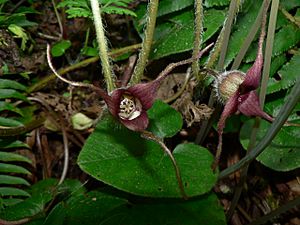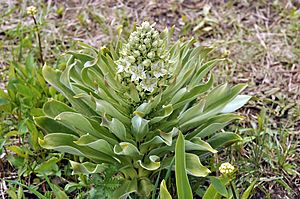List of dicotyledons of Montana facts for kids
There are over 2,100 different kinds of dicotyledon plants found in Montana! These plants are a big part of Montana's natural beauty, from tiny wildflowers to tall trees. Scientists at the Montana Natural Heritage Program keep track of these plants, and some are even called "Species of Concern" because they might be rare or need special protection.

Contents
What Are Dicotyledons?
Dicotyledons, often called "dicots," are a major group of flowering plants. The word "dicot" means "two cotyledons." A cotyledon is the first leaf or leaves that appear from a plant seed. If a plant has two of these tiny seed leaves when it sprouts, it's a dicot!
Here are some cool things about dicots:
- Two Seed Leaves: As mentioned, their seeds usually have two cotyledons.
- Net-like Veins: If you look closely at a dicot leaf, you'll see the veins branch out like a net.
- Flower Parts in Fours or Fives: Their flowers often have petals or other parts in groups of four or five, or multiples of these numbers.
- Ringed Stems: Inside their stems, the plant's "pipes" (called vascular bundles) are usually arranged in a ring.
Many common plants you see every day are dicots, like roses, sunflowers, oak trees, and beans!
Discovering Montana's Dicot Orders
Scientists group plants into different categories to help us understand them better. One of these groups is called an "order." An order is a collection of plant families that share similar features. Think of it like organizing books in a library by genre – all the mystery books go together, even if they're by different authors.
Montana is home to many different dicot orders. Here are a few examples of the interesting plant orders you can find there:
Common Plant Orders in Montana
- Asterales: This order includes many familiar flowers like sunflowers, daisies, and dandelions. They often have flowers made up of many tiny florets.
- Ranunculales: This group includes plants like buttercups and columbines. Many of them are known for their beautiful, often colorful flowers.
- Lamiales: This order is home to many plants with square stems and often fragrant leaves, like mints and lavender.
- Fagales: If you see an oak tree or a birch tree, you're looking at a member of the Fagales order! These are often important forest trees.
- Rosales: This order is famous for the rose family, but it also includes many fruit trees like apples, cherry trees, and even strawberry plants!
- Caryophyllales: This diverse group includes plants like cacti, carnations, and beets. They can look very different from each other!
Special Dicot Plants to Know
Montana has some unique and interesting dicots. Here are a few:
Flax Plants
The flax order (Linales) includes plants known for their strong fibers and oily seeds.
- Linum lewisii, also called prairie flax, is a beautiful blue-flowered plant native to Montana.
- Linum usitatissimum, or common flax, is grown for its seeds (linseed) and fibers, which can be used to make linen fabric.
Ginger Plants
The Ginger order (Aristolochiales) includes plants like the wild ginger.
- Asarum caudatum, or wild ginger, is a low-growing plant with heart-shaped leaves and unique, brownish-purple flowers that grow close to the ground. It has a spicy, ginger-like scent.
Milkworts
The Milkworts order (Polygalales) contains plants like the milkworts.
- Polygala alba, or white milkwort, is a small plant with delicate white flowers.
Oleasters
The Oleasters order (Proteales) includes shrubs and small trees.
- Elaeagnus angustifolia, known as Russian olive, is a tree with silvery leaves.
- Shepherdia argentea, or silver buffaloberry, is a shrub with silvery leaves and red berries.
Peony Plants
The Peony order (Dilleniales) has beautiful, large-flowered plants.
- Paeonia brownii, the western peony, is a native peony found in parts of Montana, known for its deep red or maroon flowers.
Sundews
The Sundews order (Nepenthales) includes fascinating carnivorous plants!
- Drosera rotundifolia, the roundleaf sundew, is a small plant with sticky leaves that trap insects for food. It's amazing to see how they catch their prey!
Water Milfoil
The Water Milfoil order (Haloragales) includes plants that live in water.
- Myriophyllum sibiricum, common water-milfoil, is a plant that grows underwater in lakes and ponds.

Studying these different plant orders helps us understand the amazing variety of life in Montana and how all these plants fit into the larger natural world. It's like a giant puzzle, and each plant order is an important piece!

